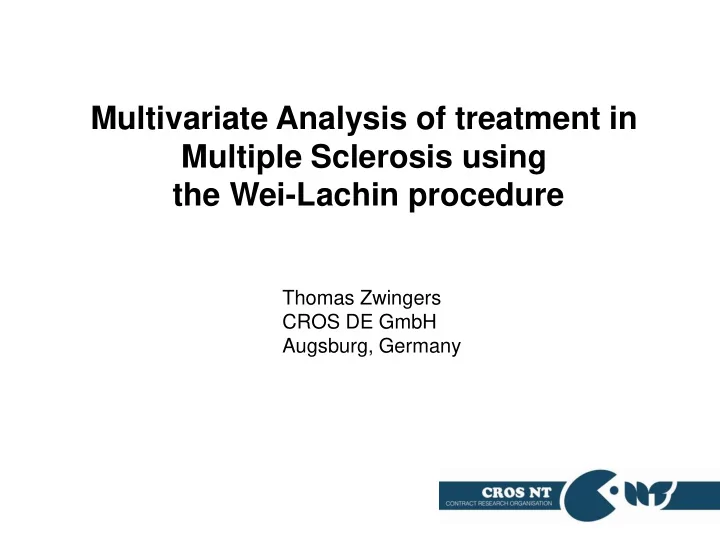

Multivariate Analysis of treatment in Multiple Sclerosis using the Wei-Lachin procedure Thomas Zwingers CROS DE GmbH Augsburg, Germany
Multivariate Analysis of treatment in MS using the Wei-Lachin procedure The problem • Multiple endpoints with equal priority in MS: o progression of the disease measured through the Expanded Disability Status Scale (EDSS), o Standard Neurological Status (SNS), o Ambulation Index (AI), o the number of attacks requiring corticosteroid treatment, o time to the first attack requiring such treatment.
Multivariate Analysis of treatment in MS using the Wei-Lachin procedure Nature of endpoints • EDSS is a scale ranging from 0 to 10 in steps of 0.5; • AI is a scale ranging from 0 to 9 in steps of 1, • SNS is a scale ranging from 0 to 99 in steps of 1; • Number of attacks is a count variable and • Time to 1 st attack is a duration.
Multivariate Analysis of treatment in MS using the Wei-Lachin procedure There was no generally acceptable composite score that could be adopted. A Bonferroni adjustment was impractical due to the large number of endpoints. Multivariate Analysis
Multivariate Analysis of treatment in MS using the Wei-Lachin procedure Additional medical requirement None of the endpoints is allowed to be worse in the active treatment group directional test
Multivariate Analysis of treatment in MS using the Wei-Lachin procedure The solution Multivariate test which is able • to combine variables of different nature and • to test directional alternatives H 0 : Θ k = 0 for all k=1,2,3,4,5 (variables tested) H 1 : Θ k >= 0 for all k=1,2,3,4,5 with at least one k>0; non-pa non param amet etric test st of of O’ O’Br Brie ien type pe Wei ei-La Lachi hin test st
Multivariate Analysis of treatment in MS using the Wei-Lachin procedure The test statistic Z derived from the Wei-Lachin procedure has an asymptotic normal distribution and is defined as: Z = (J’ Θ ) / [J’ S J] 1/2 with Θ being the vector of Mann-Whitney-differences between the treatment groups; S being the covariance-matrix of Q and J being a vector of weights. This test statistic is the nonparametric equivalent to Hotelling’s one-sided parametric T² test.
Multivariate Analysis of treatment in MS using the Wei-Lachin procedure Study results Placebo vs. 12 mg MTX Mann-Whitney-difference p-value (95% confidence interval) Global difference 0.2941 (0.1644 – 0.4239) <0.0001 Change in EDSS 0.2393 (0.0414 – 0.4373) 0.0194 Change in AI 0.2107 (0.0240 – 0.3974) 0.0306 No. Of attacks 0.3693 (0.1740 – 0.5645) 0.0002 Time to 1st treated attack 0.4431 (0.1974 – 0.6888) 0.0004 Change in SNS 0.2302 (0.0299 – 0.4305) 0.0269
Multivariate Analysis of treatment in MS using the Wei-Lachin procedure Summary • Endpoints often have different nature (counts, scores, mean values, time to event) • Non-parametric tests using the Mann-Whitney difference can be a solution • Such tests are of special interest in closed testing procedures
Recommend
More recommend